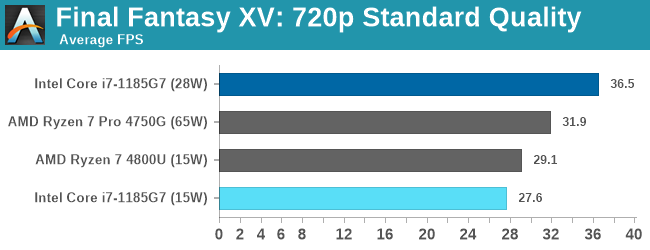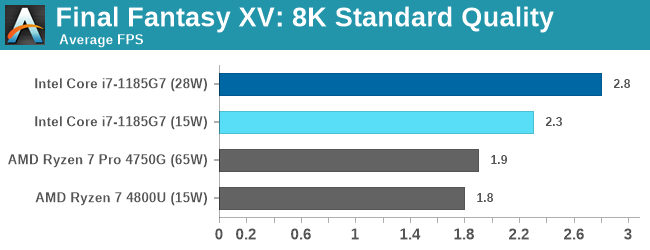Intel’s Tiger Lake 11th Gen Core i7-1185G7 Review and Deep Dive: Baskin’ for the Exotic
by Dr. Ian Cutress & Andrei Frumusanu on September 17, 2020 9:35 AM EST- Posted in
- CPUs
- Intel
- 10nm
- Tiger Lake
- Xe-LP
- Willow Cove
- SuperFin
- 11th Gen
- i7-1185G7
- Tiger King
Xe-LP GPU Performance: Final Fantasy XV
Upon arriving to PC, Final Fantasy XV: Windows Edition was given a graphical overhaul as it was ported over from console. As a fantasy RPG with a long history, the fruits of Square-Enix’s successful partnership with NVIDIA are on display. The game uses the internal Luminous Engine, and as with other Final Fantasy games, pushes the imagination of what we can do with the hardware underneath us. To that end, FFXV was one of the first games to promote the use of ‘video game landscape photography’, due in part to the extensive detail even at long range but also with the integration of NVIDIA’s Ansel software, that allowed for super-resolution imagery and post-processing effects to be applied.
In preparation for the launch of the game, Square Enix opted to release a standalone benchmark. Using the Final Fantasy XV standalone benchmark gives us a lengthy standardized sequence to record, although it should be noted that its heavy use of NVIDIA technology means that the Maximum setting has problems - it renders items off screen. To get around this, we use the standard preset which does not have these issues. We use the standard quality settings.


OK so testing at 8K was a complete accident. In that pure GPU limited scenario, Intel is ahead. When at 720p in a more standard combination of settings, Intel's 28 W goes above the 65 W desktop integrated graphics, but is behind when stuck in 15 W mode.











253 Comments
View All Comments
Spunjji - Thursday, September 17, 2020 - link
Came here to leave an identical comment before I've even read the article 😂DigitalFreak - Thursday, September 17, 2020 - link
The Tiger King puns are getting old.huangcjz - Thursday, September 17, 2020 - link
I still don't get it...Luminar - Thursday, September 17, 2020 - link
RIP AMDtipoo - Friday, September 18, 2020 - link
You haven't had the...Well I can't say pleasure, of watching Tiger King thenFlunk - Thursday, September 17, 2020 - link
Wow, this naming scheme is even worse than the previous one. I've been patiently explaining to people for years that the number after the I is less important than that last letter.E.G. H > U > Y
I can't even imagine how you'd explain this to someone who isn't a hardcore enthusiat. You basicallly need to look up each CPU number to know where in the stack it is. Might as well give up on the numbers entirely.
wr3zzz - Thursday, September 17, 2020 - link
I am with you but it sounds like the 85 in 1185G7 is the new U.ingwe - Thursday, September 17, 2020 - link
Agree with Ian and Andrei. The power/naming shenanigans are just miserable.Spunjji - Thursday, September 17, 2020 - link
Intel's product naming division is its own circle of hell.CajunArson - Thursday, September 17, 2020 - link
You guys really REALLY need to update NAMD to the 2.14 nightly builds to get a real idea of what Willow Cove can do in a workload that is very heavily used in HPC: https://www.hpcwire.com/2020/08/12/intel-speeds-na...